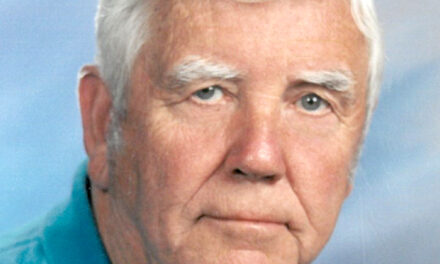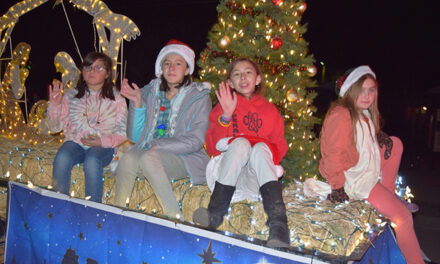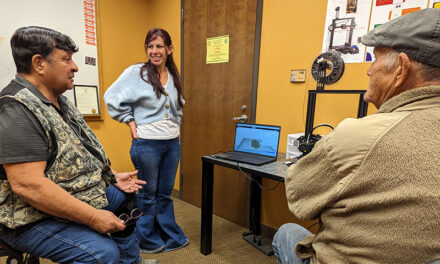Rescued birds educate and inspire through New Mexico Raptors
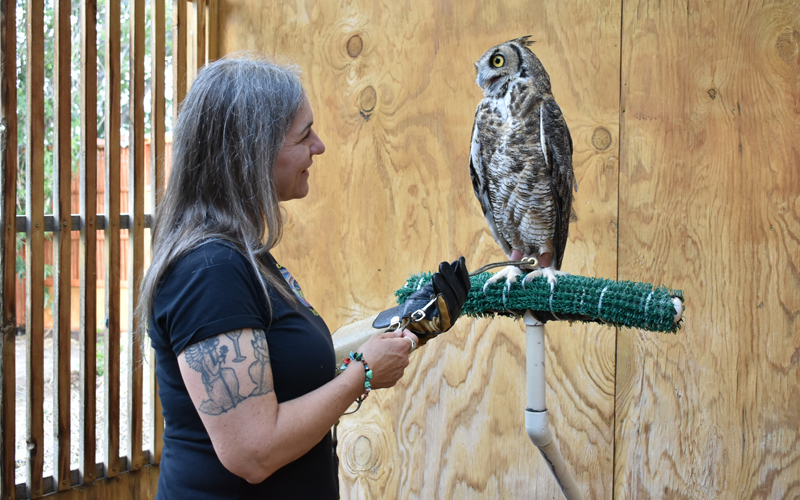
Felina Martinez | News-Bulletin photos
Laura McCann gets her Great Horned Owl, Nuru, set up in equipment that tethers him to her glove. This is how McCann displays her birds at live birds-of-prey educational presentations.
PERALTA — What began as backyard birding for Laura McCann has evolved into New Mexico Raptors, a thriving birds-of-prey rescue based in Peralta.
McCann, who is the founder and president of New Mexico Raptors, currently cares for five birds of prey deemed unreleasable.
These birds reside with McCann and serve as animal ambassadors for their species through educational live bird-of-prey presentations she conducts statewide.
“My whole focus is on conservation education and understanding the importance of raptors in our ecosystems, and how to conserve them,” said McCann, who is also the education manager for the Valencia Soil & Water Conservation District.
Before joining VSWCD, McCann was an elementary school teacher. Her interest in raptors began in 2002 when she noticed two hawks behind her house and wasn’t sure what they were.
“I got a bird book and identified them. Later, I saw Wildlife Rescue of New Mexico was doing an open house, and they were going to have their educational birds, and I was like, ‘I want to see that.’ I asked them how I could volunteer, and I went. I helped at their clinic for a long time.”
From there, McCann went on to assist with Avian Ambassadors and Hawkwatch International. She became interested in starting her own rescue after learning more through mentors, volunteer work and self education.
She’s also had formal training at the Minnesota Raptor Center on care and management of captive raptors. Equipped with all the knowledge needed, McCann then launched New Mexico Raptors in 2006.
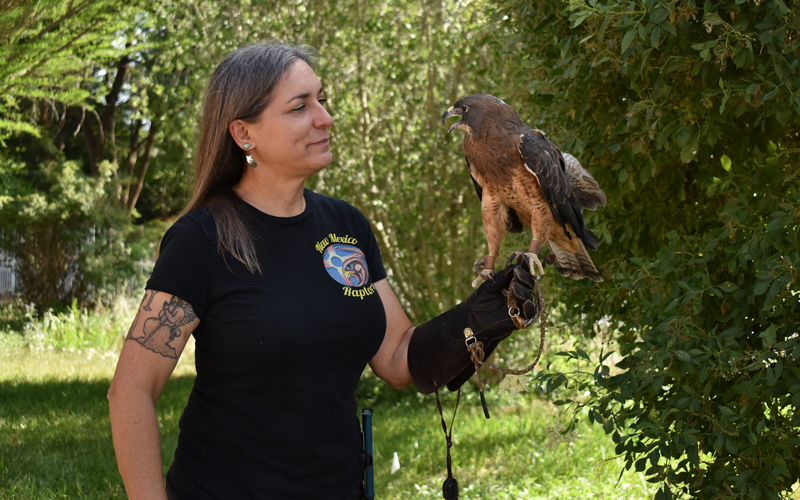
Laura McCann displays her oldest raptor, Kree, who is a Swainson’s Hawk. Kree, who is 29-years-old, has been with McCann since the start of NM Raptors.
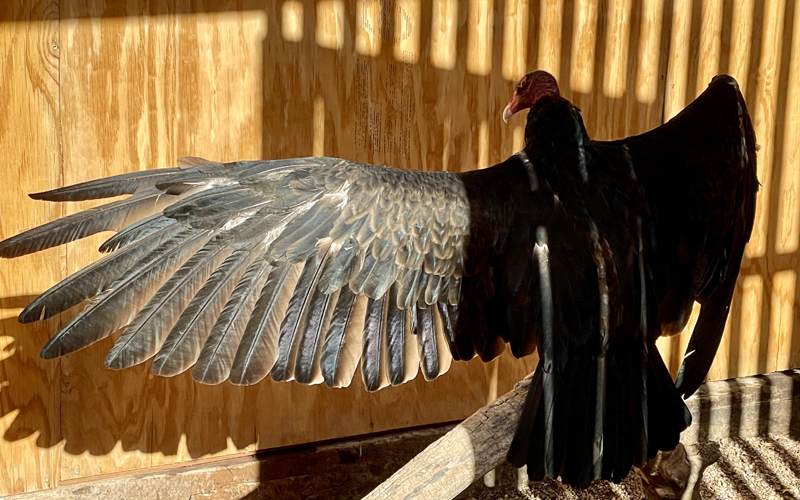
McCann’s Turkey Vulture named Aeolus spreads her wings. Aeolus was deemed non-releasable due to a wing break that left her unable to fly. Photo courtesy of Laura McCann.
“It’s my labor of love,” said McCann. “I’m not a full-time rehabilitator. I rescue and move them on to rehab and do education. I do have state and federal permits to legally possess the birds.”
McCann said the conservation of birds of prey is important for several reasons. One being that these birds help maintain balance within the ecosystem.
“Prey species have lots of babies. It’s part of their adaptation to survive, but if you don’t have predators in your ecosystem that help keep those numbers in check, you get an overpopulation of prey species,” she said. “Many of those prey species eat plants, so they’ll damage the habitat without predators like raptors and cause an imbalance.”
Raptors are also important because they are bioindicators, meaning they are species that show how well an ecosystem is doing.
“If we have a good number of raptors in the ecosystem, that’s an indication of a healthy ecosystem because they must have enough to eat or they wouldn’t be here. If they have enough to eat, that means whatever they’re eating has enough to eat and so on,” said McCann.
Most raptors are solitary, which is why they generally do so well in captivity, said McCann. The oldest of her raptor’s is Kree, a Swainson’s hawk that is 29 years old.
“Kree has been here with me since the get-go, and she is way old,” McCann said. “Even in captivity, they normally have about a 10 to 15 year lifespan.”
Kree found her way to McCann after she was shocked on a telephone wire.
“She had burns on her foot and wing. The scarring made her wing a bit shorter and made her fly sideways instead of straight,” she said. “Swainson’s migrate as far south as Argentina. She wouldn’t be able to make it that far with her injury, so they didn’t release her.”
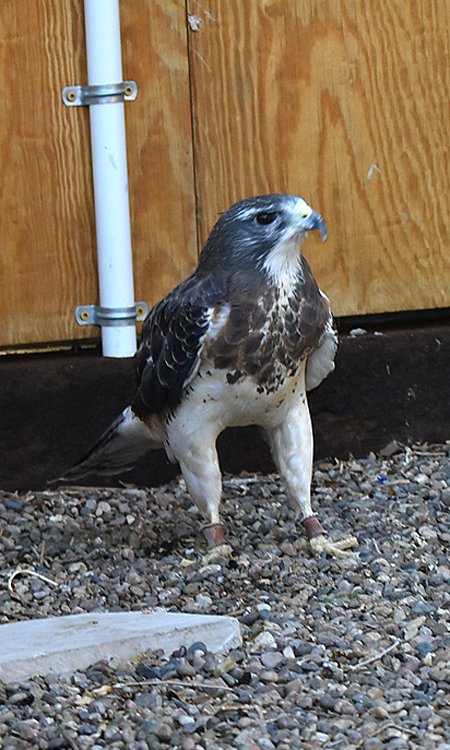
McCann’s Swainson’s Hawk, named Scout, walks along the floor of his pen. Scout is still in training, but McCann says she hopes to start brining him to shows soon.
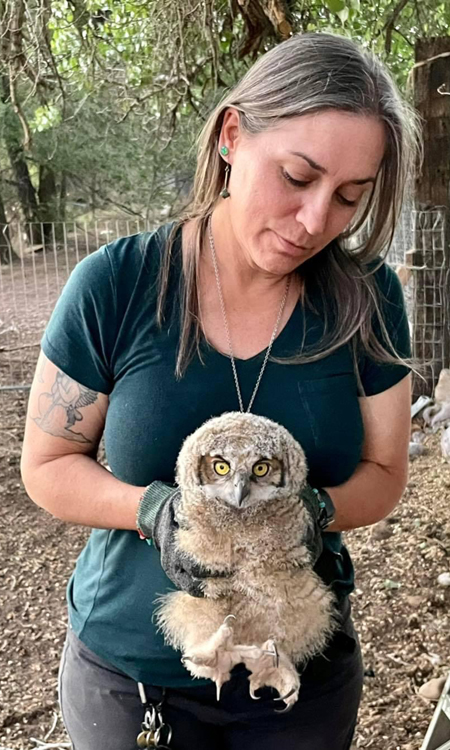
In 2022, McCann was called out to help a fledgling Great Horned Owl that lost its perch and fluttered to the ground. Not able to fly yet, McCann helped it get back on the tree knowing its parents were nearby. Photo courtesy of Laura McCann.
Her other Swainson’s hawk, named Scout, was brought to McCann after he was confiscated from someone raising him illegally.
“He’s still in training and doesn’t do shows on the glove as of yet because he’s an imprint, meaning somebody illegally raised him by hand when he was a baby, probably with the best of intentions, but you can’t do that,” she said. “Not only is it illegal, but the birds have to imprint on their own species, or at least similar species. Otherwise, they don’t know they’re a hawk.
“Wild birds teach their young to be quiet around humans, but since he imprinted on a human, he thinks he has to yell for food when I’m around which makes taking him to presentations difficult,” McCann said. “He seems to be chilling out the older he gets, so I’m hoping he can start being in shows soon.”
McCann’s red-tailed hawk, named Tuuli Haukka, was brought to her in 2009 after he was discovered near the road on Interstate 25.
“He’s near and dear to my heart because he was found in Belen. He was found by prisoners picking up trash along the highway. If you can walk up to a bird that’s wild, that means there’s something wrong with it,” she said. “When he came in, he had head trauma and damage to one eye from a car strike. His head trauma healed, but he can’t see out of that eye, which puts him at a disadvantage in the wild.”
McCann’s great horned owl, Nuru, was found near Alamogordo in 2009 with the exact same car-strike injury as her red-tailed hawk.
Her turkey vulture, named Aeolus, was found on the ground near Bosque del Apache.
“She had a wing break near the wrist and must have been on the ground for two weeks at least because it had already healed over, which means she’ll never fly because it froze the joint,” McCann said. “She was deemed non-releasable as soon as they found her.”
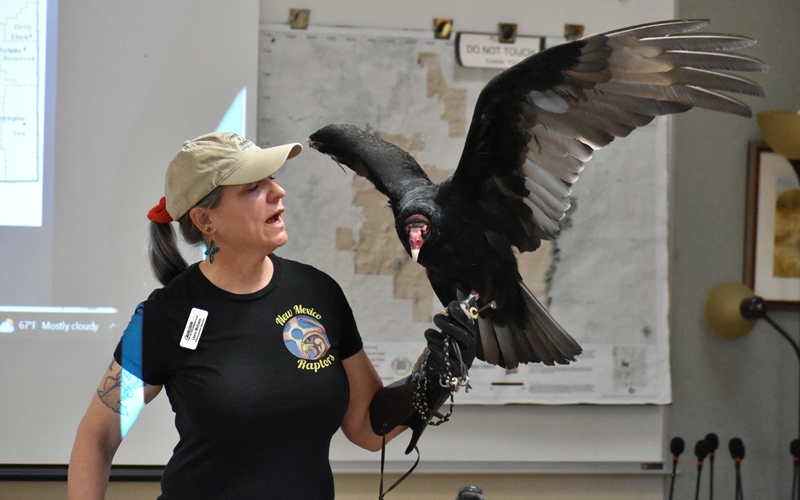
McCann displays her rescued Turkey Vulture at presentation held at Whitflied in April. McCann’s birds serve as animal ambassadors for their species through educational presentations she conducts statewide.
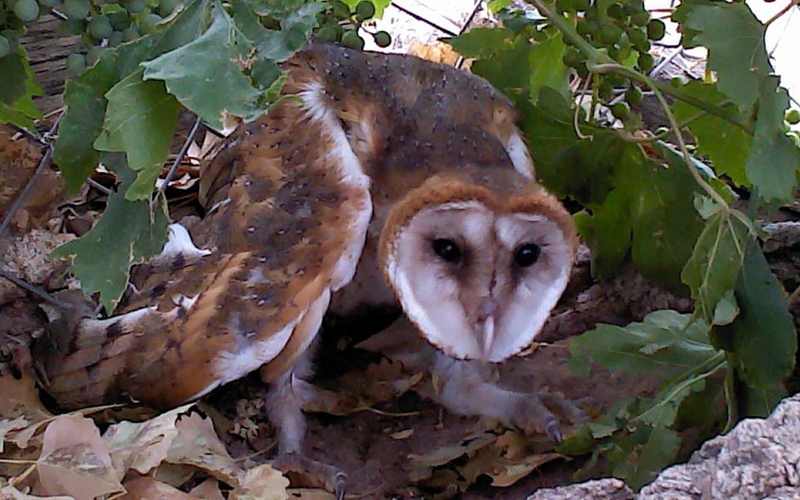
McCann helped rescue this fledgling Barn Owl, who fluttered to the ground but couldn’t yet fly. With the help of a bucket truck, they put it back up in the tree. Photo courtesy of Laura McCann.
Many of the injuries sustained by birds in rehabilitation are man made. To combat this, McCann shares some small things we can do that can have a big impact on their conservation.
“We get a lot of injuries from car strikes. If I’m driving down quiet country roads at night, I’ll put my brights on because then I can see more to the side,” she said. “And just if you see a bird, just tap your brakes. Usually all they need is a few more seconds to clear the car.”
Another big one is rodenticide. Poisoned rodents make a quick snack for raptors, which will lead to secondary poisoning and kill the bird. McCann suggests using snap traps instead and to make sure all food is packaged up and access points for rodents into your home are sealed to prevent rodents from being there in the first place.
“Another danger for these birds is pesticides. I’m not saying you can never use a pesticide, but really be careful in application and don’t use them widespread; it’s bad for your soil anyway,” said McCann.
If you notice you have a dangerous wire on a telephone pole, McCann said you can call PNM and they usually will modify it so that the birds have a perch above the wires.
“Another thing to remember is that all native birds are protected by the Migratory Bird Treaty Act,” McCann said. “You’re not supposed to kill them or disturb their nesting. If you can’t stand that the bird is nesting at your house, take it down in late fall when the breeding season is over and talk to professionals about how to keep them from nesting on your buildings.
“Don’t do it in the breeding season because it disturbs their life cycle. We have had a lot of this around here with the cliff swallows. ”
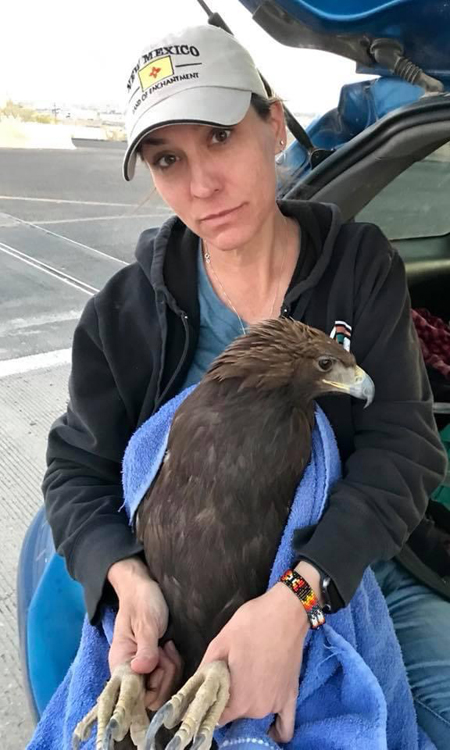
McCann sits with a Golden Eagle she was called out to rescue in 2018. The eagle was extremely malnourished. She took him to the Santa Fe Raptor Center but he unfortunately died within a day. McCann said he at least had a peaceful place to spend his final hours. Photo courtesy of Laura McCann.
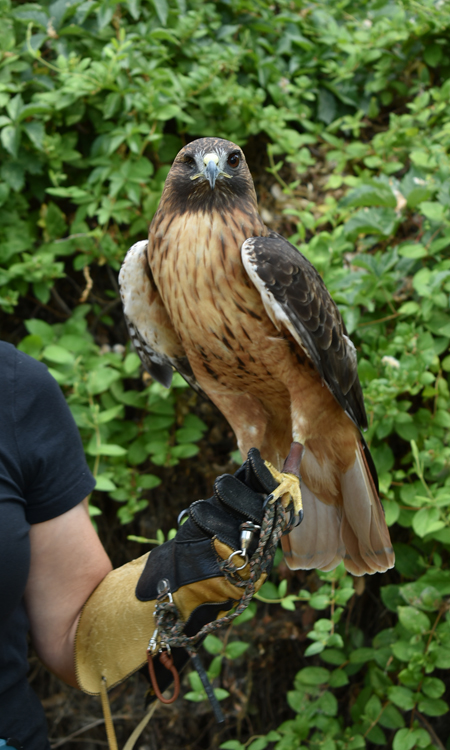
McCann’s rescued Red-tailed Hawk sits upon her glove. The hawk was rescued in 2009 after being struck by a car which left him blind in one eye.
McCann said to get in contact with a licensed wildlife rehabilitation agency or individual if you come across an injured bird. If you don’t know where one is in your area, contact New Mexico Department of Game and Fish, because they have a list of who has permits in your area.
“Don’t get hurt yourself though. These animals can be dangerous unless they’re really down. If able, you can put them in a cardboard box with a lid somewhere quiet, but you’ll need to get it to a licensed rehabilitator within 24 hours,” said McCann.
McCann said she is working on expanding New Mexico Raptors into a 501c3 non profit and plans on establishing a website soon after. In the meantime, she encourages people to follow New Mexico Raptors on Facebook and Instagram to stay in the know.
Requests for McCann’s live bird-of-prey presentations can be sent to [email protected]. To donate to the New Mexico Raptors, visit rodentpro.com/Charities/Donate.
“Working with wildlife is something else I teach at my programs. We don’t always have to get rid of wildlife, we need to learn to exist alongside wildlife,” said McCann. “One slogan I’ve had for a long time is ‘We become aware, because we care’.”
Felina Martinez was born and raised in Valencia County. She graduated from the University of New Mexico in 2021. During her time at UNM, she studied interdisciplinary film, digital media and journalism. She covers the village of Los Lunas, Los Lunas Schools, the School of Dreams Academy and the town of Peralta.

